Are you feeling optimistic? How is your outlook right now?
If I’m being honest, this is the most hopeful I’ve been in quite a few years. And if you look around there are a few good reasons to think that way:
- AI continues to show new amazing use cases that help make our lives better…all while making us better at our jobs, not taking them.
- New innovations are emerging all around us, like the awe-inspiring rocket catch by SpaceX recently (on the first try!).
- Economically, things seem to be improving, with interest rates decreasing, the job market stabilizing, and a whopping 84% of small business owners showing optimism for 2025.
Of course, there are things to still work on and improve, but I’m excited to see what 2025 brings for me personally, the Lighthouse team, as well as the country and world as a whole.
In this week’s edition, we take a look at a big mindset shift that’s important for leaders (another lesson from Steve Jobs!), discuss a big gap between what executives & HR think vs front line team members, and share some of our favorite quotes on leadership you may enjoy, too.
Let’s dive in…
Table of contents:
- 🥘 Food for Thought on Learning vs. Fixing Problems
- 📰 News & Reports for Managers on a Big Leadership Disconnect
- 📖 Your Leadership Long Read on Great Leadership Quotes to Inspire You
- ❓ Poll of the Week on Motivation and Burnout

➡️ Did a friend forward this to you? Get every issue straight to your inbox by signing up here.
Note: This is a preview of our weekly leadership newsletter, Lighthouse Leadership Weekly (LLW).
To get this sent to your inbox every week, along with our latest long form essays on this blog, you can sign up here.
🥘 Food for Thought on Learning vs. Fixing
Audience Member: “What’s the most important thing you personally learned at Apple that you’re doing at NeXT?”
Steve Jobs: “I now take a longer term view on people. …when I see something not being done right, my first reaction isn't to go fix it.
It's to say we're building a team here and we're going to do great stuff for the next decade, not just the next year. And so what do I need to do to help so that the person that's screwing up learns?”
As happens for me quite frequently, I came across another gem from Steve Jobs that is a great lesson in leadership for us all to think about:
Steve jobs took 18 seconds to think about his answer to this great question pic.twitter.com/jIsvy7Ikpn
— VisionaryVoid (@VisionaryVoid) November 8, 2024
Let’s take a look at the two key parts of Jobs’s comment:
1) Don’t just fix their problems for them.
One of the big temptations that especially new/first-time managers have is to come to the rescue and fix all of your team’s problems yourself.
And it’s easy to understand why we are all tempted to do that:
- You often have the expertise and experience to know the right way to do it.
- You feel like the hero and expert when you save the day.
- In the short term, it will be a lot faster.
While you may not be the best leader yet, fixing the problem is often something you are good at, so it feels comfortable and productive.
Yet, Steve Jobs is very wise in knowing why you shouldn’t do it:
- It robs your team of agency. They have learned to come to you with the problem, making them dependent on you going forward.
- They don’t improve from the experience. They haven’t learned how to solve it or avoid it altogether in the future.
- It eats up all your time if you’re always fixing things yourself, quickly putting you into a reactive management mode.
So while it may feel good, and in an absolute emergency, it could be necessary, you can’t rely on that as your primary way of managing. It will burn you out, exhaust you, and leave your team helpless and stuck.

2) Help the person that screwed up learn.
As the old proverb reminds us, the best thing you can do is empower others to be able to solve their own problems.
And that means you need to coach and teach your team, not give them the answers.
But many of us have never had a great coach at work. That means you have to learn to be an effective teacher on your own.
Here’s a few things you can do:
- Start by asking questions: We talked about this last week as well. Questions are one of the best ways to get people thinking for themselves, and avoid you giving them the answers up front. Not sure where to start? You can start with these 12.
- Ask them to come to you with possible solutions: Your team members don’t have to bring fully baked or perfect ideas, but pushing them to think through alternatives and present at least a starting point gets them really thinking. It also helps make sure that you fully consider all options, because you don’t always have all the information they do.
- Remember to apply Task Relevant Maturity: As we preach often, you should be more hands-on when someone is new to a task or struggling. That means if they screwed up, you should be more hands-on and supportive. And as the handy TRM table tells us, you should ask them the, “What, when, why, and how.”
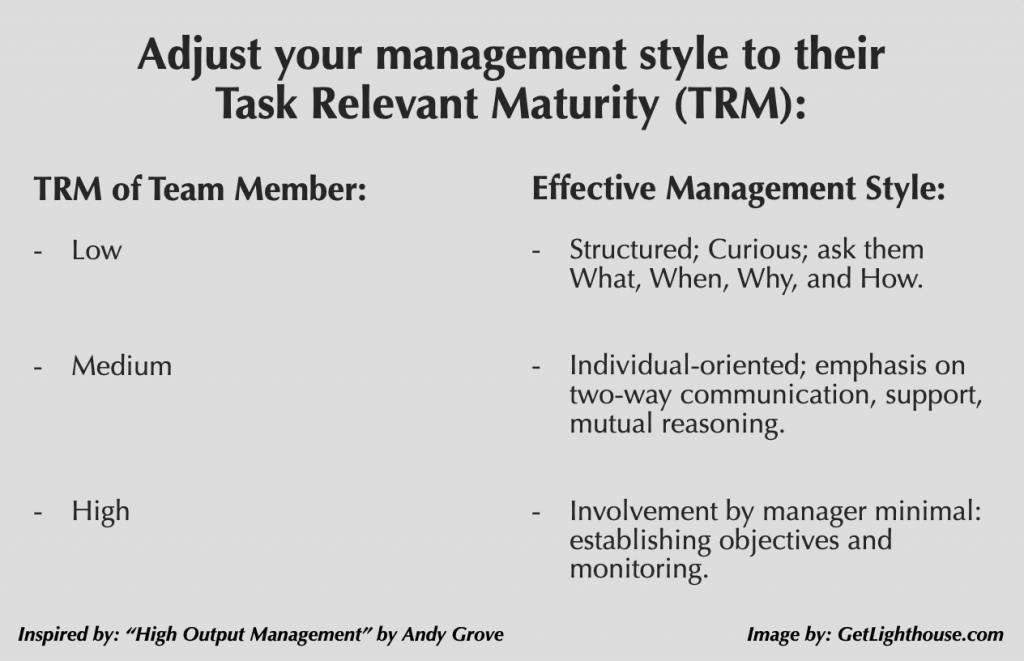
Is this more work in the short term? Absolutely.
But you know what’s A LOT more work over time? Your team coming to you for every little thing, completely dependent on you for solutions to every hiccup or setback.
When you instead take this approach, you slowly teach your team how to solve their own problems. This empowers them and helps them grow. That motivates your best people to keep getting better, and most importantly, makes them more independent.
That independence then grows into mastery and trust. And before you know it, your team is performing at a high level, and all you have to do is help coordinate and coach at a high level.
That’s how you turn “screw ups” into great teams, and set yourself up to be known as a great leader in your organization, with the results to match.
🤔 Take a minute this weekend and reflect: Are you giving your team the answers, or teaching them how to solve their own problems?
📰 News & Reports for Managers
Executives and HR think much more highly of their company culture than employees…
I’m always on the lookout for new data that helps identify blind spots leaders have, and to help us all confirm theories we may have, but only understand anecdotally.
And this week, I came across a new report that talks about yet another disconnect between what executives and HR think, and the reality for most employees.
Fortune shared a summary of takeaways from a report by a company called Dayforce.
Now, I’m normally skeptical of company-made reports, because shocker! they tend to have findings that support their products and services.
Yet, when you scrape away their self-promotion, this one impressed me with a few of their insights. And most importantly, they had the sample size to actually draw useful conclusions (they had 9,489 respondents).
So here’s the key takeaways and lessons that you need to know:
1) 70% of respondents have turned down a job because they don’t like the culture of a company.
This is a big one. Your company culture may be hurting you, and you don’t even know it.
When someone turns down a job offer, it’s easy to chalk it up to “Oh, they got offered more money” or “Their friend works at the other company. We can’t compete with that.”
But maybe it’s your culture.
How you present yourself and your company to candidates can either attract or push away candidates.
Sometimes, that’s a good thing.
If you have a workaholic, go go go culture, then you want to repel people who are looking to clock out at 5:01 pm.
But if you really want a certain candidate, but you make them feel unwelcome, they’re probably going to look elsewhere.
If you’re worried you may be driving away good candidates from the start, check out this list of common interview mistakes and work on fixing them.
2) Executives and HR Leaders overestimate how great their culture is by 65-70%
One of the most telling stats in the report is the overconfidence execs and HR seems to have about their culture:
“While 84% of executives and 81% of HR leaders reported that their company invests in culture, only 49% of workers agree.”
That’s a substantial gap. When 8 in 10 in one group feel a certain way, but in another group, less than 5 in 10 feel the same, there’s a disconnect there.
To be honest, I’m not surprised by this gap.
Because the truth is the amount of effort it takes to have a truly great culture is an order of magnitude higher than most executives believe.
I’ve heard many times from founders and CEOs I know that they think they’re doing a lot for their culture, but a lot less of it than they expect is actually trickling down to their team. It takes a lot of conscious effort and repetition to get through.
Which is why the report also found:
“CHROs and others in the C-suite are 35% more likely than the average employee to say their organization works to continuously improve their company culture.”
And while you may think this comes down to perks, parties, and fancy cultural artifacts, it’s often much more about the fundamentals as this graphic from the report shows:

Are you building a place where your team can feel proud about where they work? If not, that’s where to start with improving your culture, not a party, “Hawaiian shirt Friday”, or trust falls.
3) Those who love where they work and promote it are generally more optimistic
One of the interesting things I noticed throughout the report is how it looked at employee NPS (Net Promoter Score).
What it found was a series of actions and beliefs carried by those who are happy at work (promoters who would recommend working there) that I think any leader would love their employees to have.
This came down to things like:
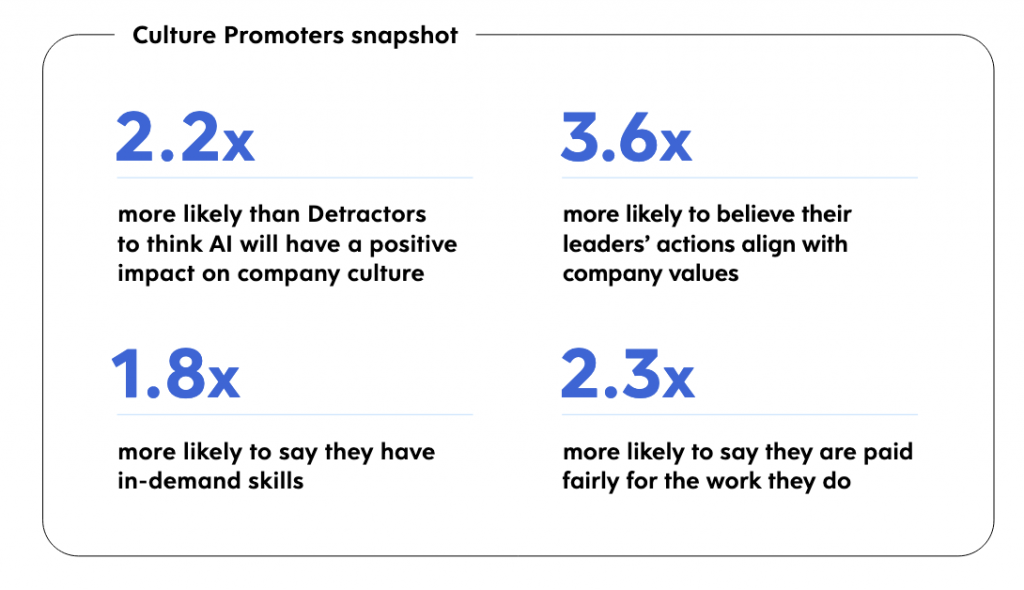
These 4 things are pretty fundamental to work today. Is it really that hard to:
- Help your team learn how AI can help them at their job?
- Coach and develop your people to continue to grow their skills and level up?
- Make sure your leaders you promote and reward live out your company values?
- Pay your employees competitively?
Actually, while that list is simple, it is far from easy.
Yet, that’s what great culture is really about.
When I lived in Silicon Valley, I had friends who worked at some of those companies that became a mockery of corporate culture. Yeah, they had free food, free drinks, big blowout parties, and cool company swag.
But you know what the truth is? If they hated their coworkers, had a jerk of a boss, or didn’t enjoy their work day to day none of that mattered.
And I’ve seen in my own work, that the fundamentals of good culture are more of that list 1-4 than it is shiny, expensive things. The perks and parties are either icing on a cake or lipstick on a pig.
If you want to have a good culture, it’s more important to check in on the fundamentals:
- Are your team members growing and learning? If not, get started now. Make a plan, and help them get there incrementally. Otherwise, you will lose your best people to new, exciting opportunities for growth at other companies.
- Remember that culture is what you do when it’s hard. Reward those living your values and make sure there are consequences for those that don’t, even if they have great numbers or results. Everything else is icing or hypocrisy.
- Compensate your team fairly. We don’t talk about this as often, but few things build resentment faster than if you are truly underpaying your staff significantly. A lot of problems go away if you can fix this, even if it includes conversations like, “I can only pay you that if you also take on X.” That’s fair and reasonable, and often necessary for the math to work.
Are you getting the fundamentals right for your culture?
Are you and your team on the same page for how your culture is really doing?
These are not easy questions to answer, but they’re important ones for you
📖 Your Leadership Long Read on Great Leadership Quotes to Inspire You
We usually give you long form essays in this section. They’re the kinds of meat and potatoes content that you really need to dig into and spend time reading it and reflecting on it.
Today’s post is more like dessert. It’s a collection of some of my favorite quotes and tweets over the years that contain important truths about leadership.
Best of all, because Wordpress has a great embed feature, if you like one, too, you can easily like, retweet, or bookmark it straight from the post’s page.
So hop over to our blog and see if you get inspired by any of them to work on a key leadership habit or two:
Read: 23 Awesome Leadership Quotes to Inspire, Motivate, and Transform You
❓ Poll of the Week
Last week, we took a look at what you consider the best way to motivate your employees:
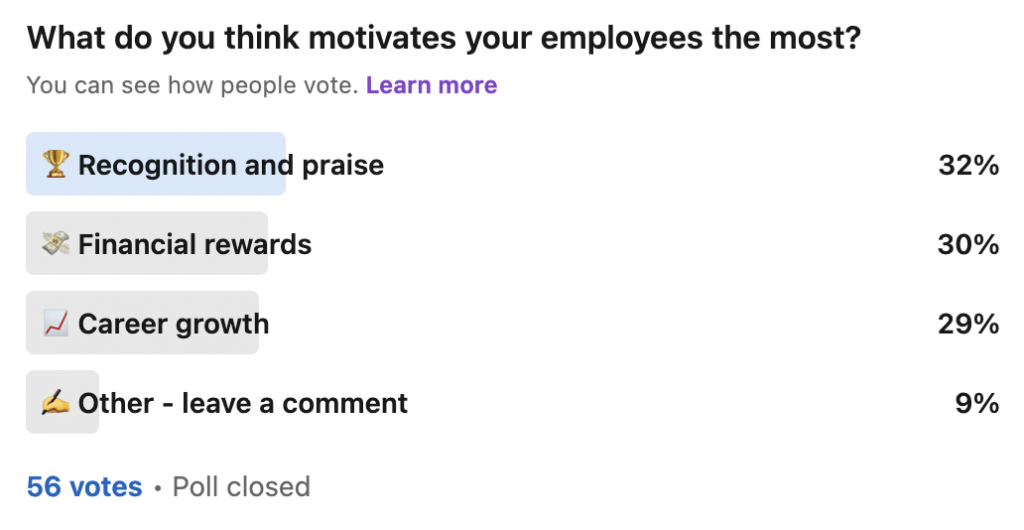
As you can see, it was basically a draw, with many of the “Other” choices contending you need to really do an “all of the above” approach.
Yet, there was also a great 4th option suggested by a Lighthouse Leadership Weekly reader that is worth calling out:
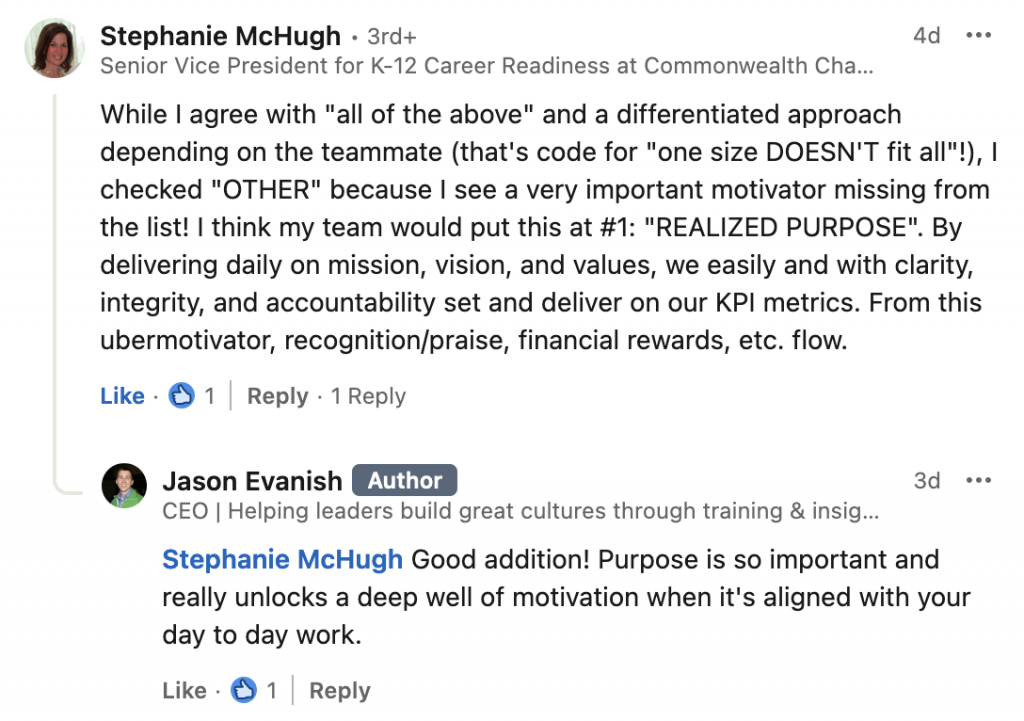
It’s a good reminder that there are many ways to motivate your team, and an “all of the above” approach is really the best.
Now, this week we talk about a common problem that too often gets ignored until it’s too late:
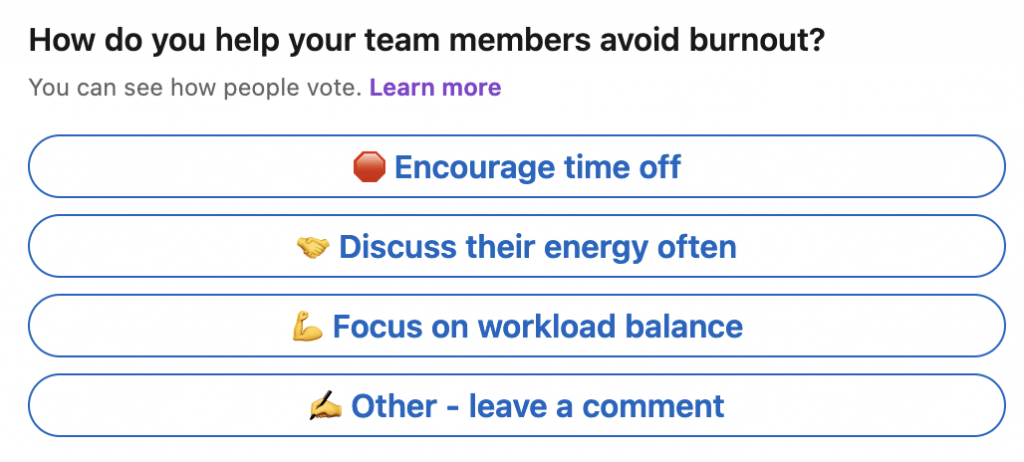
Do you help your team avoid burnout? Tell us how in this week’s poll here.
Sign up to get this newsletter & our latest blog posts straight to your inbox:




